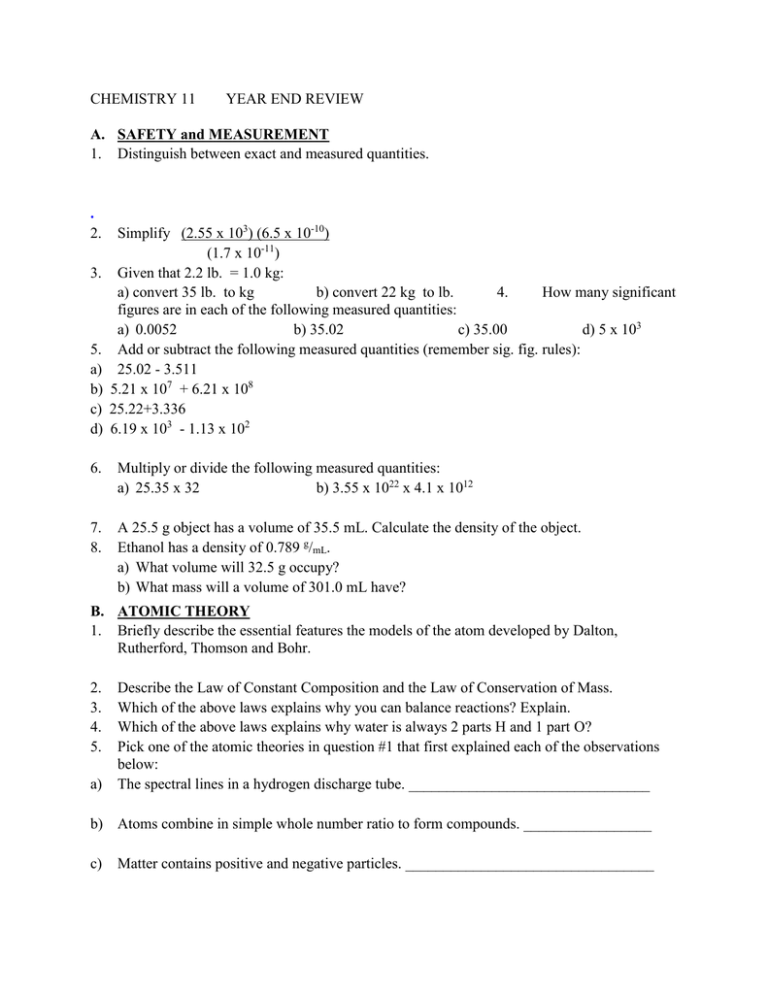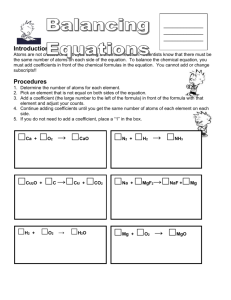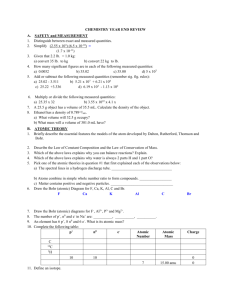CHEMISTRY 11 YEAR END REVIEW A. SAFETY and
advertisement

CHEMISTRY 11 YEAR END REVIEW A. SAFETY and MEASUREMENT 1. Distinguish between exact and measured quantities. . 2. 3. 5. a) b) c) d) Simplify (2.55 x 103) (6.5 x 10-10) (1.7 x 10-11) Given that 2.2 lb. = 1.0 kg: a) convert 35 lb. to kg b) convert 22 kg to lb. 4. How many significant figures are in each of the following measured quantities: a) 0.0052 b) 35.02 c) 35.00 d) 5 x 103 Add or subtract the following measured quantities (remember sig. fig. rules): 25.02 - 3.511 5.21 x 107 + 6.21 x 108 25.22+3.336 6.19 x 103 - 1.13 x 102 6. Multiply or divide the following measured quantities: a) 25.35 x 32 b) 3.55 x 1022 x 4.1 x 1012 7. 8. A 25.5 g object has a volume of 35.5 mL. Calculate the density of the object. Ethanol has a density of 0.789 g/mL. a) What volume will 32.5 g occupy? b) What mass will a volume of 301.0 mL have? B. ATOMIC THEORY 1. Briefly describe the essential features the models of the atom developed by Dalton, Rutherford, Thomson and Bohr. 2. 3. 4. 5. a) Describe the Law of Constant Composition and the Law of Conservation of Mass. Which of the above laws explains why you can balance reactions? Explain. Which of the above laws explains why water is always 2 parts H and 1 part O? Pick one of the atomic theories in question #1 that first explained each of the observations below: The spectral lines in a hydrogen discharge tube. ________________________________ b) Atoms combine in simple whole number ratio to form compounds. _________________ c) Matter contains positive and negative particles. _________________________________ 6. Draw the Bohr (atomic) Diagram for F, Ca, K, Al, C and Br. F Ca K Al e- 7 2 e- 7. 2 e8 e8 e2 e- 13. 14. 15. 8e8e2e- 8e2e- Br 4 e2 e- 17 e8 e8 e2 e- 6 p+ 35 p+ Mg2+ 8e2e- 9 p+ 9 p+ 9 p+ 9 p+ + 0 + The number of p , n and e in Na are: __________, __________, __________. An element has 6 p+, 8 n0 and 6 e-. What is its atomic mass? 10. Complete the following table: p+ 11. 12. 3 e8 e2 e- 9 p+ 20 p+ 19 p+ 13 p+ Draw the Bohr (atomic) diagrams for F-, Al3+, P3- and Mg2+. FAl3+ P38e2e- 8. 9. 1 e8 e8 e2 e- C n0 e- Atomic Number 6 6 1 10 7 Atomic Mass 12.00 amu 14.00 amu 3.00 amu 20.00 amu 15.00 amu C 6p+ 6n0 6e14 C 6p+ 8n0 6e3 H 1p+ 2n0 1e20Ne 10 10 10e15N 7p+ 8n0 7eDefine an isotope. Calculate the average atomic mass of magnesium given the following data: 24 25 26 Mg 78.7% Mg 10.1% Mg 11.2% Distinguish between a chemical family and a chemical period. Describe what happens to the atomic mass and number as you move to the right within a period on the periodic table. State three things that elements in the same chemical family have in common. 16. Circle each reactive atom or ion. a) Na b) Na+ c) S d) S2- e) He Charge 0 0 0 0 17. Complete the following chart. p+ Li+ 3p+ Mg2+ 12p+ S 16p+ 2S 16p+ Ne 10p+ n0 4n0 12n0 16n0 16n0 10n0 e2e10e16e18e10e- No. of valence e1 e8 e6 e8 e8 e- C. CHANGES IN MATTER 1. Define physical and chemical change. Physical change is a change in the state of matter of a chemical (or appearance) while a chemical change involves a change in the chemical structure (as a result of a chemical reaction which involves a rearrangement of atoms). 2. Circle each example of chemical change. a) iron rusts b) silver tarnishes c) ham is sliced d) water evaporates e) ice sublimes f) gasoline burns g) salt dissolves h) steam condenses i) water is converted into H2 and O2 The examples of chemical change are: i) water is 3. Define exothermic and endothermic change. Exothermic change involves the giving off or release of energy (usually heat) and endothermic changes involves the absorption of energy (heat). 4. Describe each as exothermic or endothermic. a) 2 H2 + O2 2 H2O + 500J b) 200 J + 2 KClO3 (s) 2 KCl + 3 O2 (g) c) H2O (s) H2O (g) d) H2O (g) H2O (l) 5. Define the following changes in state: evaporation, freezing, condensation, sublimation and melting. 6. At 100˚C determine the phase (solid, liquid or gas) for each of the following compounds: a) m.p. 20˚C b.p. 120˚C b) m.p. 105˚C c) b.p. 25˚C 7. Define element, compound and mixture. 8. Describe each as an element, compound or mixture. a) A homogeneous brown substance has a constant composition. After heating in a vacuum it gives off a gas and leaves a silver liquid. b) A homogeneous purple solid has a constant composition. After heating the solid in a vacuum it evaporates and re-condenses upon cooling. The molten solid does not decompose when an electrical current is passed through it. c) A liquid has a boiling point of 105˚C. After boiling the liquid for 10 minutes, the boiling point changes to 110˚C. 9. Define metals and non-metals. 10. Describe how you could separate a mixture of sand and water.. 11. Describe how you would separate a mixture of ethanol and water by distillation. Draw a labeled diagram of the apparatus used. In your explanation include the boiling points of water and ethanol and the terms: distillation flask, condensation tube and collecting flask. D. CHEMICAL COMPOUNDS 1. Circle each ionic compound. a) NaBr b) KOH c) HCl d) NH4C1 2. Write correct ionic formula for each combination. a) Mg ; C1 b) NH4 ; O c) Fe ; S d) A1 ; SO4 3. Name each compound in the above question. 4. Define and give an example of a cation and anion. 5. Circle each cation. a) K+ b) C1- c) NaBr e) CH4 f) NH3 d) NH4OH 6. Circle the formulas that have formula units. a) CCl4 b) H20 c) C12 d) NaF e) NH4Br 7. Circle the compounds that conduct electricity. a) Na (s) b) NaCl (s) c) NaCl (aq) d) NaCl (l) e) CCl4 (l) f) H2O (l) g) CH3OH (aq) h) NH4OH (aq) 8. Write dissociation equations for: a) Na2CO3 b) Fe2(SO4)3 9. Draw Lewis structures for: a) CCl4 b) H2 c) CO2 d) C2H2 10. Arrange the compounds into the four categories: ionic, acids, or molecular Na2SO4 H2SO4 CCl4 C2H6 KOH NH4OH CH3COOH NH4C1 11. Explain why NaCl and CCl4 are stable compounds. 12. Circle the molecular compounds. a) H2O b) HCl 13.Name each binary molecular compound. a) CCl4 b) CO2 c) P2O5 c) NaBr d) NH4OH d) SiCl E. REACTIONS 1. Complete, balance, and identify each reaction type. Write NR for those reactions that do not occur (use Activity Series to determine this - only for SR reactions). All phases must be included! a) C6H14 + O2 CO2 + H2O b) Al2(SO4)3 + AgNO3 c) NaCl + KOH d) Au + Cu(NO3)2 e) Cu + Au(NO3)3 f) H2SO4 + NaOH g) HgO h) Ca + H2 O i) Al + I2 2. Write a balanced chemical equation to show how solid iron reacts with oxygen from the air to produce solid iron (III) oxide. Include all phase symbols. 3. Write a normal double replacement for Cu(NO3)2 (aq) + NaOH (aq). Write the total ionic and net ionic equations for this reaction. F. 1. 2. 3. 4. 5. 6. 7. 8. 9. 10. 11. 12. 13. 14. 15. MOLE CONCEPT State Avogadro’s number and hypothesis. Define molar mass. If 3.50 moles of an element has a mass of 14.0 g, calculate its atomic molar mass. What is the element? Calculate the number of moles in 50.0 L of H2 (g). Calculate the number of grams in 35.2 moles of cobalt. Calculate the number of atoms in 6.25 moles of copper atoms. Calculate the number of moles of water molecules that is equal to 7.55 x 1022 molecules of water. Calculate the number of formula units of NaCl in 5.60 g of NaCl. Calculate the mass of 2.65 x 1027 atoms of iron. Calculate the percent composition of each element in C2H6O. A compound is 32.38% Na, 22.58% S and 45.07% O. Calculate the empirical formula of the substance. Check your formula with the table of radicals. What is the empirical formula of C6H6? A molecular compound has an empirical formula of CH2 and a molecular mass of 84 g/mol. Determine the molecular formula. How many moles of H2 gas at STP are in 100.0 L? How many litres of NH3 gas at STP are in 2.5 moles? G. BONDING 1. Draw an ionic crystal lattice for NaCl. 2. 3. 4. 5. 6. 8. Explain how two atoms bond ionically. Explain how two atoms bond covalently. Illustrate your answers with examples. What does electronegativity refer to? Find the electronegativity of the following atoms from your periodic table: Na, F, Br, S, O, Ca, Fr, Cu. Draw the Lewis and structural diagrams of the following molecules. State their shape if possible. Determine whether they are polar or not. a) Cl2 b) C2Cl2 c) PH3 d) HCN e) CCl4 f) H2O g) CH3OH h) N2H4 a) C2H4 b) C2H5Cl Describe the three kinds of intermolecular forces and provide drawings to illustrate. 7. What does the term isoelectronic mean? Explain why CH4 has a much lower boiling point than H2O (they are isoelectronic chemicals!) H. PERIODIC TABLE 1. Draw an outline of the periodic table and indicate where each chemical family is located. State where the metals and non-metals are located. Describe the trends of ionization energy and atomic radius. 2. State what is meant by ionization energy and provide an equation to show the ionization of Ca atoms. 3. Which is larger: metal atoms or metal ions? Explain. 4. Which is larger: non-metal atoms or non-metal ions? Explain. 5. In which chemical family is each element located? Cl, K, U, Ca, Xe, Fe, Ru, Lw 6. State the periodic law. I. STOICHIOMETRY 1. How many chlorine atoms are in 5 formula units of MgCl2? 2. How many moles of Br are in 10.0 moles of AlBr3? 3. Given the reaction: 2 H2 + O2 2 H2O How many moles of H2O are produced by a) 5 moles O2 and b) 5.0 g O2 ? 4. If the actual yield is 50.0 g and the theoretical yield is 70.0 g, what is the percentage yield? 5. Given: 2 Fe2O3 + 3 C 4 Fe + 3 CO2. If 50.0 g of Fe2O3 completely reacts with excess carbon, how many grams of carbon dioxide are produced? 6. C3H8 (g) + 5 O2 (g) 3 CO2 (g) + 4 H2O (g). If 205g of C3H8 (g) reacts with excess O2 (g), calculate the theoretical yield of CO2 (g). If the actual yield of CO2 was 500.0 g, calculate the percentage yield.. 7. 2 H2 (g) + O2 (g) 2 H2O (l) How many grams of H2O are produced when 50.0 L of H2 (g) at STP reacts completely to form water. 8. 9. J. 1. 2. 3. 4. 5. 6. 7. 8. 2 NaCl 2 Na + Cl2. How many litres of Cl2 (g) are produced at STP when 100.0 g of NaCl completely react. 2 H2 (g) + O2 (g) 2 H2O (l) If 8 moles of H2 (g) reacts with 3 moles O2 (g), determine the amount (moles) of H2O (l) produced, the limiting reactant and the amount of excess reactant. SOLUTION CHEMISTRY Pick the compounds that would be soluble in CCl4. a) NaCl b) CBr4 c) C2H2 d) HF e) H2O Calculate the number of grams NaCl required to prepare 100.0 mL of a 0.200 M solution. Calculate the number of litres of NaCl required to obtain 0.50 g if the solution is 0.20 M. How many moles NaCl are in a 0.20 L of a 0.50 M solution. 25.0 moles NaOH is dissolved in 50.0 L of H2O. What is the molarity? If 25.0 g NaOH is dissolved in 5.0 L of H2O, what is the concentration? If 25.0 mL of a 6.0 M NaOH solution is diluted to 100.0 mL, what is the new molarity? You are given the equation H2SO4 + 2 NaOH Na2SO4 + 2 H2O and that 50.0 mL of 0.20M NaOH is required to neutralize 25.00 mL H2SO4. What is the acid concentration? K. ORGANIC CHEMISTRY 1. Name each organic structure a) ____ b) _________________________ c) _________________________ d) ____________________ e) f) _________________________ g) ____________________________________ h) _________________________________________ | 2. Draw the structural formula for each organic chemical. a) 1,1-dibromopentane b) 3,3,4 - trimethylhexane c) 4-ethyl-5-methyldecane d) 2-hexene e) 4-octyne f) cyclohexane g) 2-methyl-4-chloro-3-octene 3. Draw all of the structural isomers of C5H12.





